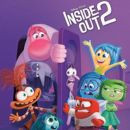Inside Out 2
The moment I heard that Pixar was releasing a sequel to one of my all-time favorite films, “Inside Out,” my anticipation reached stratospheric levels. The original remains an emotional touchstone, masterfully portraying the intricacies of human emotions. “Inside Out 2” sets itself a daunting challenge: to reprise that magic while presenting a fresh perspective. From the poignant introduction to its stellar animations, Kelsey Mann’s feature directorial debut manages to navigate these waters rather successfully. Here’s my detailed exploration of this compelling sequel.
Introduction to the Concept
“Inside Out 2” dives back into the vibrant, intricate world of teenage emotions. This time, our protagonist, Riley is not the broad-smiled pre-adolescent girl we once knew but a 13-year-old navigating the choppy waters of puberty. The film opens with a familiar atmosphere, as Joy (voiced by Amy Poehler) and the gang are busily managing Riley’s emotional landscape.
However, the serenity is short-lived. The narrative quickly introduces new emotions such as Anxiety (Maya Hawke), Embarrassment (Paul Walter Hauser), Ennui (Adèle Exarchopoulos), and Envy (Ayo Edebiri). These characters mark the onset of Riley’s teenage turmoil, adding both complexity and humor to her emotional ecosystem. The film’s concept smartly expands on the foundation laid by its predecessor while skillfully addressing the adolescent phase.
Historical Context and Background
The original “Inside Out” was a groundbreaking narrative on how emotions influence our behavior, celebrated for its creative storytelling and emotional depth. This set the bar exceptionally high for the sequel. The storyline picks up just as Riley embarks on her teenager journey, providing historical continuity while introducing new complexities.
What’s commendable is how “Inside Out 2” maintains the charm of the first film while navigating uncharted territory. The scene where Riley’s friends Grace (Grace Lu) and Bree (Sumayyah Nuriddin-Green) are introduced is especially nuanced, presenting her close-knit social circle that adds further texture to her emotional life. This blend of continuity and novelty is crucial to the sequel’s success.
Why Inside Out 2 is Intriguing
The film’s intrigue lies in its ability to depict the roller coaster of teenage emotions. One standout moment is when Riley, overwhelmed by a late-night alarm signaling the start of puberty, finds herself dealing with a whole new set of emotions. From the moody Ennui to the ambitious and overly cautious Anxiety, these characters vividly encapsulate the confusing feelings teenagers often face.
The narrative tension heightens when Riley discovers that her best friends will be attending different high schools. The ensuing struggle, orchestrated primarily by Anxiety, to transform Riley into someone who can gain the approval of her hero, Val Ortiz (Lilimar), introduces themes of identity and peer pressure. This emotional turbulence is effectively visualized, making the viewing experience both relatable and engaging.
Visual and Animation Excellence
Pixar continues to set the benchmark for animated films, and “Inside Out 2” is no exception. The movie dazzles with bursts of color and brilliant animation, transporting viewers into the vibrant terrain of Riley’s mind. Each new emotion is meticulously designed to embody its traits – Anxiety, for instance, has a jittery, almost electrified appearance that conveys its restless and preemptive nature.
The landscapes within Riley’s mind, from the glimmering underground lake that fuels her core beliefs to the distant, dimly lit ‘back of the mind’ where forgotten memories reside, are rendered with exquisite detail. These settings are not only visually arresting but also serve as symbolic backdrops that enhance the film’s narrative depth.
Character Development and Dynamics
One of the film’s notable strengths is its focus on character development, particularly the interplay between Joy and the new emotions. Initially sidelined by Anxiety’s scheme, Joy embarks on a journey to reclaim Riley’s authentic self. This quest showcases her indomitable spirit while allowing her to confront her limitations.
The chemistry among the emotions remains delightful. Sadness (Phyllis Smith) continues to bring a nuanced depth to her role, especially in scenes where she interacts with Embarrassment. The film successfully showcases the importance of every emotion, underlining how even seemingly negative feelings are indispensable to personal growth.
Strengths and Shortcomings
Despite its many strengths, the film is not without its shortcomings. Some of the new emotions, like Envy, don’t leave a lasting impact and occasionally fade into the backdrop. The humor derived from Ennui’s French beatnik persona, while initially amusing, begins to wear thin after a while.
Moreover, the film’s portrayal of Riley’s diverse friends as stepping stones for her personal growth feels somewhat reductive. Grace and Bree’s character arcs could have been more autonomous rather than being entirely directed toward Riley’s development. This aspect underscores a recurring issue where supporting characters are utilized merely as catalysts for the protagonist’s growth.
A Reflection on Adolescence
At its core, “Inside Out 2” is a touching reflection on the troubles and triumphs of adolescence. The film portrays Riley’s struggle to fit in, please others, and navigate her evolving identity with remarkable poignancy. The narrative adeptly balances moments of humor with heartfelt scenes, making it a profoundly affecting experience.
Scenes like Riley nearly levitating with joy on the ice, free from the pressures of competition and social approval, beautifully capture the message of finding intrinsic happiness. This moment is a testament to the film’s sensitive storytelling, offering both young and adult viewers valuable insights into the joy of self-acceptance.
Personal Impressions and Takeaways
Watching “Inside Out 2” felt like a cathartic journey through the labyrinth of teenage emotions, akin to revisiting my own turbulent adolescent years. The film's ability to balance light-hearted humor with poignant messages makes it a compelling watch. Joy’s journey, punctuated with setbacks and triumphs, left me reflecting on the importance of embracing every emotion as part of the human experience.
The finale, where Riley’s genuine joy shines through, struck a chord with me. It’s a reminder of how the pursuit of happiness often lies in authenticity rather than superficial achievements. The film underscores the timeless lesson that self-acceptance and inner joy are the ultimate victories.
Conclusion
“Inside Out 2” successfully extends the legacy of its predecessor, delivering a vibrant, emotionally rich narrative that resonates with audiences of all ages. Despite some minor flaws, the film remains a poignant exploration of adolescence, emphasized through brilliant animation and compelling character dynamics. It highlights the importance of cherishing every emotion and finding joy in being true to oneself.
In an age where animated films often aim for the spectacular, “Inside Out 2” grounds its storytelling in emotional authenticity. This makes it not just a worthy sequel but a needed reminder that understanding our emotions is the first step toward understanding ourselves.
Great
Latest Reviews
-
Simulation
FarmVille: Tropic Escape
![]() The idea of escaping to a tropic island is one I would support any day, mainly because of my crazy everyday schedule. However, since that...
Read full review
The idea of escaping to a tropic island is one I would support any day, mainly because of my crazy everyday schedule. However, since that...
Read full review
-
Simulation
Bus Simulator
![]() A lot of bus simulator games promise to give you the real bus driver experience, but they do not deliver on the promise. Before I...
Read full review
A lot of bus simulator games promise to give you the real bus driver experience, but they do not deliver on the promise. Before I...
Read full review
-
Simulation
Flight Simulator
![]() I've always believed that being a pilot is one of the most awesome professions out there. Sadly, the path to becoming a pilot wasn't one...
Read full review
I've always believed that being a pilot is one of the most awesome professions out there. Sadly, the path to becoming a pilot wasn't one...
Read full review
-
Adventure
Gacha World: Create your own team and conquer evil
Gacha World is an Asian role-playing project with anime graphics, MMO component, battles, raids on bosses and knocking out various valuable items from monsters. The... Read full review
Also recommended
-
Movies & TV Shows
Coco
![]() Embracing the Melody of Ancestry and Dreams
In the diverse landscape of animated films, "Coco" emerges as a luminous beacon of cultural celebration, emotional depth, and...
Read full review
Embracing the Melody of Ancestry and Dreams
In the diverse landscape of animated films, "Coco" emerges as a luminous beacon of cultural celebration, emotional depth, and...
Read full review
-
Casual
Talking Tom Cat
![]() If you're a parent, it's likely you've heard echoes of the app known as Talking Tom Cat. Renowned for its immense popularity among children, this...
Read full review
If you're a parent, it's likely you've heard echoes of the app known as Talking Tom Cat. Renowned for its immense popularity among children, this...
Read full review
-
Casual
Clash Royale
![]() Keeping up with success as massive as that of Clash of Clans would have certainly proved a challenge for any game developer other than Supercell....
Read full review
Keeping up with success as massive as that of Clash of Clans would have certainly proved a challenge for any game developer other than Supercell....
Read full review
-
Movies & TV Shows
Oscars 2024: 96th Academy Awards
![]() As the film industry continues to evolve, the 96th Academy Awards stand as a beacon of progress and inclusion within the realm of cinematic excellence....
Read full review
As the film industry continues to evolve, the 96th Academy Awards stand as a beacon of progress and inclusion within the realm of cinematic excellence....
Read full review
-
Role Playing
Gacha Cute
![]() In the vivid fantasy realm of digital gaming, Gacha Cute Mod carves its unique niche with an artistic twist. Developed by Akemi Natsuky, this 2D...
Read full review
In the vivid fantasy realm of digital gaming, Gacha Cute Mod carves its unique niche with an artistic twist. Developed by Akemi Natsuky, this 2D...
Read full review
-
Action
Super Mario Bros.™ Wonder
![]() Super Mario games hold a legendary status in the world of video games, carving a significant impact since their inception. Yet, some fans feel the...
Read full review
Super Mario games hold a legendary status in the world of video games, carving a significant impact since their inception. Yet, some fans feel the...
Read full review
Articles
-
![Conquer Apex Legends: A Comprehensive New Player's Guide]() Conquer Apex Legends: A Comprehensive New Player's Guide
Conquer Apex Legends: A Comprehensive New Player's Guide
-
![Instagram's New Dislike Button: A Step Forward or Backward?]() Instagram's New Dislike Button: A Step Forward or Backward?
Instagram's New Dislike Button: A Step Forward or Backward?
-
![Anticipated Early PC Release for GTA VI: Insights from Corsair]() Anticipated Early PC Release for GTA VI: Insights from Corsair
Anticipated Early PC Release for GTA VI: Insights from Corsair
-
![YouTube Premium's New Audio Enhancement: A Closer Look]() YouTube Premium's New Audio Enhancement: A Closer Look
YouTube Premium's New Audio Enhancement: A Closer Look
-
![Beginner's Guide to Mastering Elden Ring: Tips and Strategies]() Beginner's Guide to Mastering Elden Ring: Tips and Strategies
Beginner's Guide to Mastering Elden Ring: Tips and Strategies
-
![ChatGPT Introduces New Task Scheduling Feature for Enhanced User Experience]() ChatGPT Introduces New Task Scheduling Feature for Enhanced User Experience
ChatGPT Introduces New Task Scheduling Feature for Enhanced User Experience

















